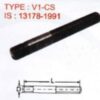Features
- Design: Clamping studs typically have a threaded end that can be inserted into a component and a head (often hexagonal) that allows for tightening.
- Material: They can be made from various materials, including steel, stainless steel, and alloys, depending on the required strength and resistance to corrosion.
Uses
- Machinery: Commonly used in equipment and machinery to hold parts securely in place.
- Automotive: Often found in engine assemblies, suspensions, and other critical components.
- Construction: Used for clamping components together in structural applications.
Installation
- Insert: The stud is threaded into a pre-drilled hole in one component.
- Positioning: The parts to be clamped are aligned together.
- Tightening: A nut is threaded onto the stud and tightened to create a secure connection.
Advantages
- Strong Connection: Provides a reliable and robust fastening solution.
- Adjustable: Can be easily adjusted or removed if needed.
- Versatile: Suitable for a wide range of applications across various industries.
Considerations
- Load Capacity: It’s important to choose a clamping stud that can handle the specific load requirements of your application.
- Corrosion Resistance: For environments that expose fasteners to moisture or chemicals, selecting the appropriate material is crucial.










